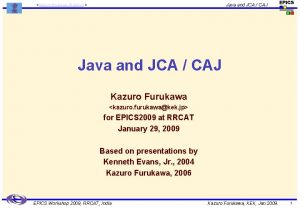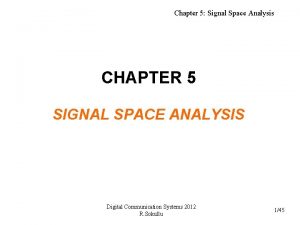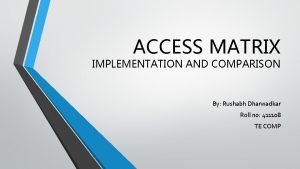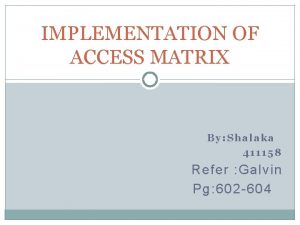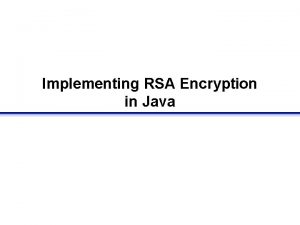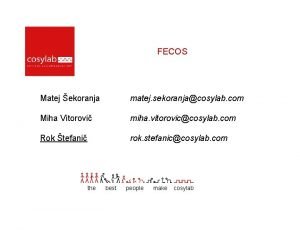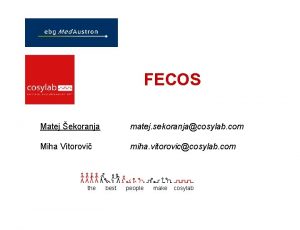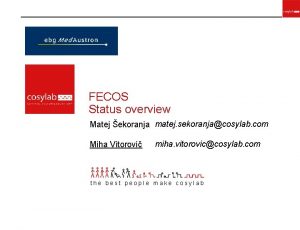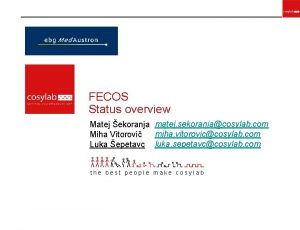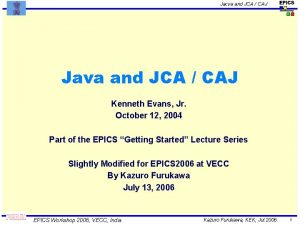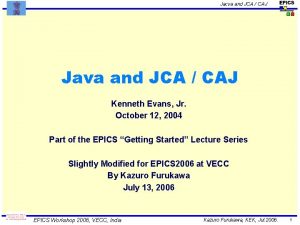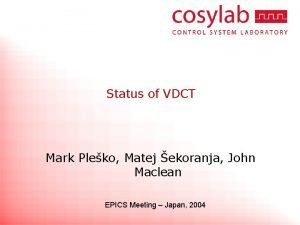Java implementation of Channel Access CAJ Matej ekoranja










- Slides: 10

Java implementation of Channel Access (CAJ) Matej Šekoranja (presented by Mark Pleško) Funded by DLS (M. Heron) and DESY (M. Clausen) EPICS Meeting – Japan, 2004

What is CAJ? • Channel Access in Java (CAJ) is a CA client library written completely in Java • It “plugs” into JCA 2 interfaces • Written as a result of detailed analysis of existing CA library to provide better stability and performance opposed to the current JCA JNI implementation • Since it was written from scratch code is clean, follows OO design and uses lots of design patterns • No problems with native libraries (no recompilation needed)

Achieving stability • The main reason CAJ was written is stability - JCA JNI was not hard to crash with our Control. Desk application for the DLS (extensive concurrent connect, monitor creation and value retrieval) • Profound testing during the whole development cycle • ~ 90% of code coverage! • Code simplicity helped a lot (simple code leads to less bugs) • ‘TCP Reno’-like UDP congestion control • Until now “only” 3 CAJ bugs were discovered • 2 by Ken Evans

Achieving performance • Latest concurrent, network communication design patterns used to implement efficient event demultiplexing, minimize context switching and maximize CPU cache affinity (Leader/Followers design pattern used) • Asynchronous I/O used (Java NIO package) • new epoll-based selector supported, which is improved select(); available in the latest Linux 2. 6 kernel • (Some performance measurements will be shown later) • Due to OO design light CAJ version is possible (one communication thread), convenient for light CA clients (handhelds)

Immediate JCA JNI to CAJ migration Simply change (example): jca. create. Context(JCALibrary. JNI_SINGLE_THREADED); OR jca. create. Context(JCALibrary. JNI_THREAD_SAFE); jca. create. Context(JCALibrary. CHANNEL_ACCESS_JAVA); … and take care of configuration. Note that CAJ can not use system environment variables like EPICS_CA_ADDR_LIST (not available in Java 1. 4, but available again in Java 1. 5).

OO Usage of JCA

Performance measurements • Client on the same host as server, Pentium IV 1. 6 GHz, 1 GB RAM, Red Hat 9 • "no bulk" means calling flush. IO() after each get request Note: this is only synthetic performance test and doesn’t reflect performance in practice!

Comparing to C Version of CA • Completely different approaches: • C pointer versus Java object creation • Java is clean, C is dirty but quick • Based on CA 4. 11, should be compabitle down to 4. 0 • But has not been tested • Backward compatibility might be an issue • several undocumented features in the C version, might have missed one

User Experiences • Control Desk • was limited to some 300 PVs before • Joi. Mint • just got ported to JCA 2 so it can use CAJ • JProbe (Ken Evans ported it to JCA 2). • “I have tested it on all the dbr types. Like my performance test, it is an application that requires a large subset of the features provided by CA. I think CAJ is looking good. ” • “Moreover, my test program, which accesses 100 PVs updating at 10 Hz, worked *much* better. Before, there were dropouts. Now, it seems to keep up. Cool!”

Conclusions • Needs some time (production usage) to confirm maturity • JCA still has much room for performance improvements, now that JNI isn’t the bottleneck anymore • Open possiblities for more user friendly applications based on Java • develop a CAJ server to integrate other Java Applications? • Proves that • other-than legacy CA implementation can be done … • CA documentation is useful and useable and that CA is not something mysterious • Cosylab needs a new task (and funding )
 Java caj
Java caj Channel design and implementation
Channel design and implementation Kos pembedahan hospital kerajaan 2020
Kos pembedahan hospital kerajaan 2020 Programa mi abogado caj bio bio
Programa mi abogado caj bio bio Antispazmatik
Antispazmatik Multi channel retailing advantages and disadvantages
Multi channel retailing advantages and disadvantages Conversion of continuous awgn channel to vector channel
Conversion of continuous awgn channel to vector channel N channel p channel
N channel p channel Access matrix implementation in os
Access matrix implementation in os Implementation of access matrix
Implementation of access matrix Java rsa implementation
Java rsa implementation
